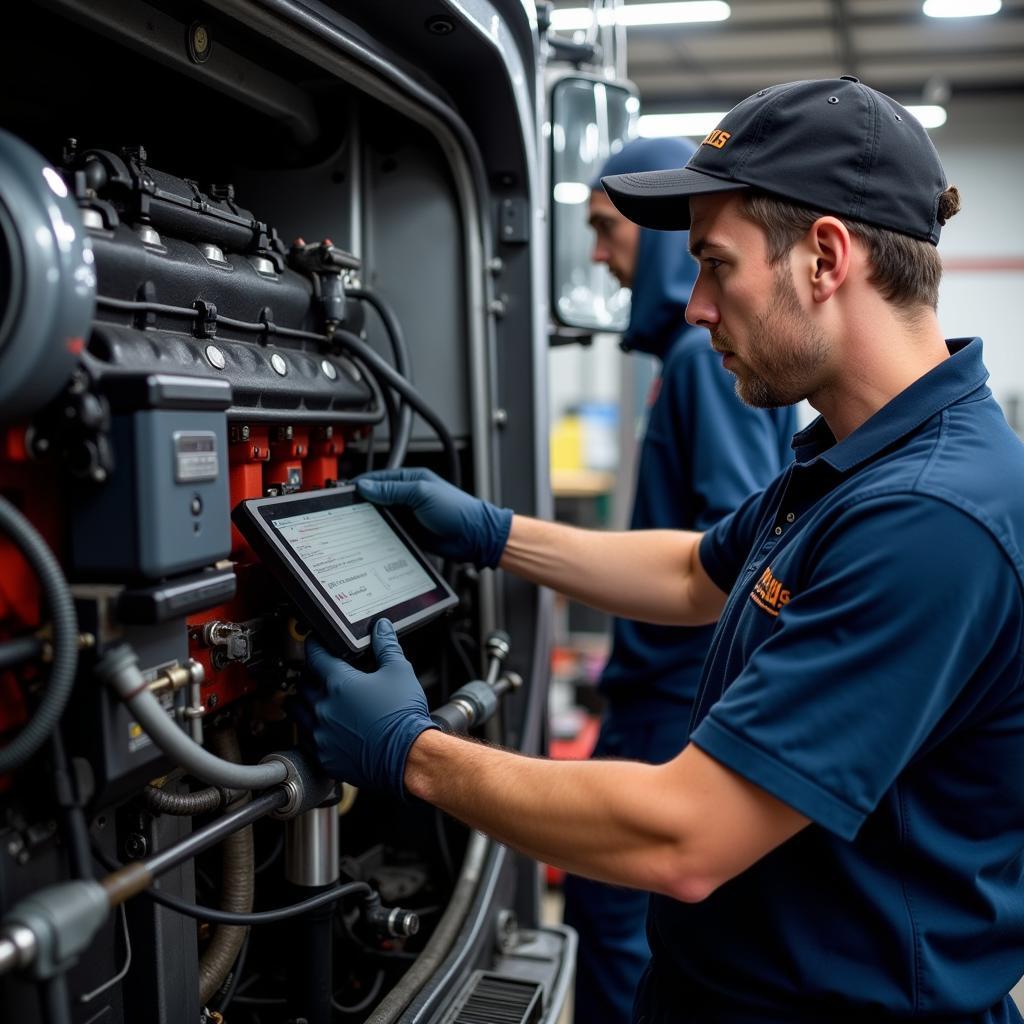In the trucking industry, time is money. Every minute a truck is off the road translates to lost revenue. That’s why having a reliable Truck Diagnostics Tool is crucial for any owner, mechanic, or fleet manager. A quality diagnostic tool helps pinpoint issues quickly, reducing downtime and saving you valuable time and money.
Why are Truck Diagnostic Tools Important?
Modern trucks are complex machines with intricate electronic systems controlling engine performance, emissions, braking, and more. When problems arise, a truck diagnostics tool acts as your window into these systems, providing the information needed to diagnose and fix issues efficiently.
Here are some key benefits:
- Accurate Diagnosis: Forget time-consuming guesswork. Diagnostic tools deliver precise error codes and live data, eliminating ambiguity and leading to quicker, more accurate repairs.
- Preventative Maintenance: Regularly scanning your truck’s systems can identify minor issues before they escalate into major problems, saving you from costly repairs and potential breakdowns down the road.
 Mechanic using a truck diagnostics tool
Mechanic using a truck diagnostics tool - Improved Fleet Management: For businesses operating multiple trucks, a diagnostics tool can be invaluable for monitoring the health of your entire fleet. This allows for proactive maintenance scheduling and ensures all vehicles operate at peak performance.
- Cost Savings: By reducing downtime and enabling preventative maintenance, a truck diagnostics tool can lead to significant savings on repair costs, towing fees, and replacement parts in the long run.
Choosing the Right Truck Diagnostics Tool
With a plethora of options available, selecting the right diagnostics tool for your needs is crucial. Consider these factors before making your purchase:
-
Vehicle Compatibility: Ensure the tool you choose is compatible with the make, model, and year of your truck (or trucks in your fleet). Some tools are specialized for certain manufacturers like Mack tools diagnostics while others offer broader compatibility.
-
Functionality: Determine the features that are most important for your needs. Do you require basic code reading and clearing, or do you need advanced functionalities like bi-directional controls, DPF regeneration, or programming capabilities?
-
User Interface: Opt for a tool with an intuitive interface and easy-to-understand menus. A user-friendly design simplifies the diagnostic process and makes the tool accessible even for those without extensive technical expertise.
-
Software Updates: Regular software updates are essential for ensuring your tool remains compatible with the latest truck models and technologies. Choose a tool from a reputable manufacturer that provides ongoing software support.
-
Budget: Truck diagnostics tools range in price from affordable options for basic diagnostics to high-end models with advanced features. Set a budget beforehand and choose a tool that offers the best value for your specific needs.
Common Uses for Truck Diagnostics Tools
- Reading and Clearing Fault Codes: The most basic function of a diagnostics tool is reading and clearing fault codes stored in the truck’s ECU (Engine Control Unit). These codes provide insights into the specific systems or components experiencing issues.
- Viewing Live Data: Monitoring live data streams allows you to observe the real-time performance of various sensors and components. This is invaluable for troubleshooting intermittent problems or verifying repairs.
- Performing Actuator Tests: Diagnostics tools can command specific actuators, such as solenoids or relays, to activate. This helps verify the functionality of these components and isolate electrical faults.
- DPF Regeneration: For trucks equipped with Diesel Particulate Filters (DPFs), a diagnostics tool can initiate a regeneration cycle, burning off accumulated soot and maintaining optimal engine performance.
- Programming and Configuration: Some advanced truck diagnostics tools offer programming and configuration capabilities, allowing you to adjust vehicle settings, update software, or even program new keys.
Mastering Truck Diagnostics: Tips and Best Practices
- Invest in Quality Training: While many diagnostics tools are user-friendly, taking the time to learn the ins and outs of your tool can significantly enhance your diagnostic abilities.
- Stay Updated: The automotive industry is constantly evolving. Stay abreast of the latest technologies, diagnostic techniques, and industry best practices.
- Consult Reliable Resources: Utilize reputable online forums, technical manuals, and manufacturer websites as valuable sources of information and troubleshooting guidance.
- Don’t Ignore the Basics: While advanced diagnostics tools are incredibly powerful, never overlook the importance of a thorough visual inspection and basic troubleshooting steps before diving into complex electronic systems.
 Mechanic visually inspecting a truck engine
Mechanic visually inspecting a truck engine - Seek Professional Help When Needed: For particularly complex issues or if you’re uncomfortable performing certain repairs, don’t hesitate to consult with a qualified truck mechanic or dealership.
Conclusion
In today’s technologically advanced trucking industry, a reliable truck diagnostics tool is no longer a luxury – it’s a necessity. By providing accurate diagnoses, enabling preventative maintenance, and empowering owners and technicians to take control of their vehicle repairs, these tools are essential for maximizing uptime, reducing costs, and ensuring the smooth operation of heavy-duty vehicles.
If you have any questions or need assistance in choosing the right truck diagnostics tool for your needs, feel free to contact ScanToolUS at +1 (641) 206-8880. We’re located at 1615 S Laramie Ave, Cicero, IL 60804, USA.

